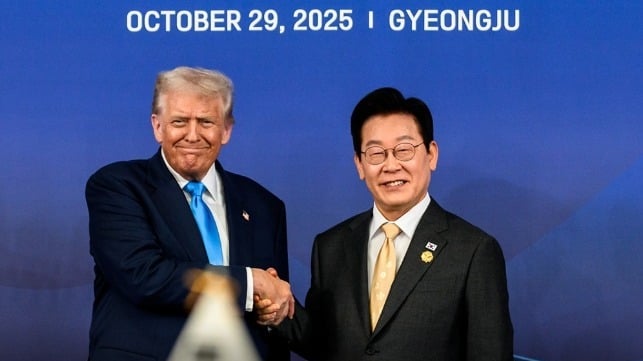APEC’s Wake-Up Call: Build Shipyard Capacity Together or Fall Behind

China’s pressure on shipbuilding and maritime investors underscores why Washington and Seoul must lead a new era of allied industrial cooperation.
As the Asia-Pacific Economic Cooperation summit opens later this week in Gyeongju, the United States and South Korea face a defining test of industrial execution. On Oct. 20, U.S. Trade Representative Jamieson Greer cautioned that Beijing is pressuring foreign firms investing in America’s shipbuilding sector, a move that directly affects financing, supply chains, and workforce expansion for U.S. yards. His warning reframed what might have been a routine trade discussion into a practical question for the maritime industry: can allied shipyards expand output fast enough to offset China’s scale and sustain throughput across the Asia-Pacific region?
Beijing’s move to penalize foreign companies involved in new shipbuilding projects in the United States highlights how government policy can influence shipyard financing, supplier contracts, and delivery schedules. The retaliation is part of a broader effort to deter allied participation in sectors that challenge China’s yard throughput and cost advantage. For Washington and Seoul, the lesson is clear: industrial cooperation must move from policy statements to executable build plans that expand capacity, protect supply chains, and keep production lines running on both sides of the Pacific.
Just ahead of APEC, Huntington Ingalls Industries (HII), America’s largest shipbuilder, and HD Hyundai Heavy Industries (HHI), the world’s largest shipbuilder, signed an agreement Oct. 26 to collaborate on distributed shipbuilding and jointly pursue navy auxiliary and commercial ship projects. The announcement shows how industry leaders are already converting policy dialogue into production alignment: sharing design methods, tooling concepts, and quality-assurance practices to raise throughput, shorten schedules, and strengthen allied yard networks that can compete at China’s scale.
Against that backdrop, U.S. and South Korean negotiators report steady progress on a trade and investment package designed to link tariff relief with new allied shipyard and supplier projects. Officials in both capitals describe the talks as constructive and indicate that a framework could unlock as much as $350 billion in joint industrial investment. The key questions now center on execution: how quickly capital can be released to modernize facilities, expand subcontractor networks, and manage foreign exchange exposure for major maritime programs. An agreement at APEC would signal to the industry that allied financing and production planning are finally converging.
South Korea’s industrial strategy underscores its expanding role in global commercial shipbuilding and its alignment with U.S. efforts to rebuild domestic maritime capacity. Seoul is investing heavily in production technologies that include robotic welding systems, AI-enabled inventory and materials management, and fully digital assembly lines that integrate design data directly into yard operations. Leading South Korean firms such as HD Hyundai Heavy Industries, Hanwha Ocean, and Samsung Heavy Industries are applying these technologies to commercial tankers, container ships, and LNG carriers while partnering with U.S. shipyards to transfer production know-how and workforce training models. By linking Korean process innovation with American infrastructure and suppliers, both nations can expand output, accelerate delivery schedules, and restore competitiveness in global vessel construction and repair markets.
This commercial partnership is also reshaping the workforce behind modern shipbuilding. South Korea’s Ministry of Trade, Industry, and Energy continues to support joint education and training programs with U.S. universities and technical institutes to prepare the next generation of marine engineers, production managers, and skilled trades. Collaborations between institutions such as the University of Michigan and Seoul National University focus on advanced design, project management, and digital production systems that link classroom learning to yard applications. By aligning academic programs with industrial needs, both countries are building a workforce capable of sustaining higher throughput, adopting emerging technologies, and driving long-term competitiveness across the maritime sector.
These collaborative developments reflect a broader shift in how the maritime industry is approaching global supply-chain resilience. By pooling capital, sharing production technologies, and aligning workforce training, the United States and South Korea are building a commercial model that other partners could adapt to strengthen their own shipbuilding and repair capacity. An agreement reached at APEC would demonstrate that open markets can coordinate industrial investment while still promoting fair competition and sustainable growth. It would also show that international cooperation among shipbuilders can offer a practical, commercially viable alternative to the state-driven production model that dominates much of the global market.
The outcome of APEC meetings will help determine whether allied governments and industry leaders can turn plans into production. A credible framework for shipbuilding cooperation would accelerate investment, expand yard capacity, and align supply chains across the Pacific. Failure to act would reinforce the perception that the United States and its partners can discuss competitiveness but not deliver it.
What’s at stake is more than trade policy; it is whether allied shipyards can build at the scale and speed required to sustain global commerce and restore balance in the maritime industry.
Jeffrey M. Voth is an engineering and technology executive focused on strengthening the US maritime industrial base.
The opinions expressed herein are the author's and not necessarily those of The Maritime Executive.
